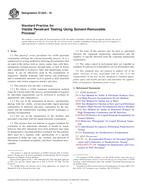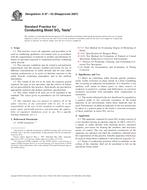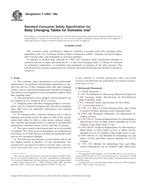1.1 This test method covers a procedure for predicting the long-term thermal resistance (LTTR) of unfaced or permeably faced rigid gas-filled closed-cell foam insulations by reducing the specimen thickness to accelerate aging under controlled laboratory conditions (1-5) .
1.2 Rigid gas-filled closed-cell foam insulation includes all cellular plastic insulations manufactured with the intent to retain a blowing agent other than air.
1.3 This test method is limited to unfaced or permeably faced, homogeneous materials. This method is applied to a wide range of rigid closed-cell foam insulation types, including but not limited to: extruded polystyrene, polyurethane, polyisocyanurate, and phenolic. This test method does not apply to impermeably faced rigid closed-cell foams or to rigid closed-cell bun stock foams.
Note 1 – See Note 7 for more details regarding the applicability of this test method to rigid closed-cell bun stock foams.
1.4 This test method utilizes referenced standard test procedures for measuring thermal resistance. Periodic measurements are performed on specimens to observe the effects of aging. Specimens of reduced thickness (that is, thin slices) are used to shorten the time required for these observations. The results of these measurements are used to predict the long-term thermal resistance of the material.
1.5 The test method is given in two parts. The Prescriptive Method in Part A provides long-term thermal resistance values on a consistent basis that can be used for a variety of purposes, including product evaluation, specifications, or product comparisons. The Research Method in part B provides a general relationship between thermal conductivity, age, and product thickness.
1.5.1 To use the Prescriptive Method, the date of manufacture must be known, which usually involves the cooperation of the manufacturer.
1.6 The values stated in SI units are to be regarded as the standard. The inch-pound values given in parentheses are for information only.
1.7 This standard does not purport to address all of the safety concerns, if any, associated with its use. It is the responsibility of the user of this standard to establish appropriate safety and health practices and determine the applicability of regulatory limitations prior to use.
1.8 Table of Contents:
| Section | |
| Scope | 1 |
| Reference Documents | 2 |
| Terminology | 3 |
| Summary of Test Method | 4 |
| Significance and Use | 5 |
| Part A: The Prescriptive Method | 6 |
| Applicability | 6.1 |
| Qualification Requirements | 6.1.1 |
| Facing Permeability | 6.1.2 |
| Apparatus | 6.2 |
| Sampling | 6.3 |
| Schedule | 6.3.1 |
| Representative Replicate Product Sheets | 6.3.2 |
| Replicate Test Specimen Sets | 6.3.3 |
| Specimen Preparation | 6.4 |
| Goal | 6.4.1 |
| Schedule | 6.4.2 |
| Specimen Extraction | 6.4.3 |
| Slice Flatness | 6.4.4 |
| Slice Thickness | 6.4.5 |
| Stack Composition | 6.4.6 |
| Storage Conditioning | 6.5 |
| Test Procedure | 6.6 |
| Thermal Resistance Measurement Schedule | 6.6.1 |
| Thermal Resistance Measurements | 6.6.2 |
| Product Density | 6.6.3 |
| Calculations | 6.7 |
| Part B: The Research Method | 7 |
| Background | 7.1 |
| TDSL Apparatus | 7.2 |
| Sampling Schedule | 7.3 |
| Specimen Preparation | 7.4 |
| Storage Conditioning | 7.5 |
| Test Procedure | 7.6 |
| Calculations | 7.7 |
| Reporting | 9 |
| Reporting for Part A, the Prescriptive Method | 9.1 |
| Reporting for Part B, the Research Method | 9.2 |
| Precision and Bias | 10 |
| Keywords | 11 |
| Mandatory Information – Qualification | Annex A1 |
| Specimen Preparation | A1.1 |
| Homogeneity Qualification | A1.2 |
| Aging Equivalence Test Procedure | A1.3 |
| Alternate Product Thickness Qualification | A1.4 |
| Example Calculations | A1.5 |
| Mandatory Information-Preparation of Test Specimens for Spray-Foam Products | Annex A2 |
| Effect Of TDSL | Appendix X1 |
| History of the Standard | Appendix X2 |
| Theory of Foam Aging | Appendix X3 |
| References |
Product Details
- Published:
- 09/15/2008
- Number of Pages:
- 9
- File Size:
- 1 file , 650 KB
- Redline File Size:
- 2 files , 1.2 MB


